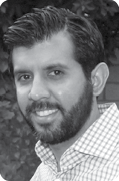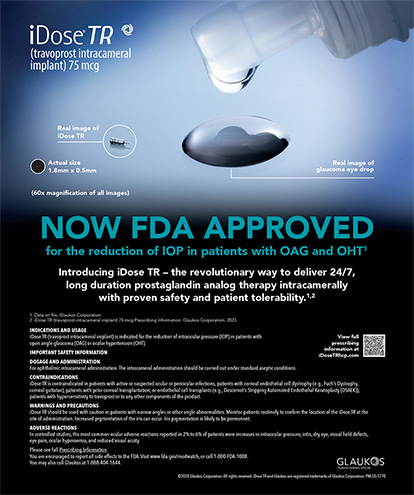
Feeling content with your current OR setup and protocol? Then, now is the time to stop, look, and listen. Complacency is the first signal that a reexamination of the flow of your OR is in order. For any business, operating at peak performance requires at least a semiannual evaluation of process. For ophthalmic practices, the most productive evaluations incorporate the views of everyone involved in executing a surgical procedure, including the front office staff, technicians, surgery schedulers, and administrators. Their insight and input will highlight areas to improve.
PLANNING AND PREPARATION
I complete all my surgical planning and calculations on the day I actually see the patient, when the case is fresh in my mind. Doing the heavy thinking beforehand allows me to focus on operating without checking and rechecking the patient’s record.
Entering information into the ORA System (Alcon) or Catalys Precision Laser System (Abbott Medical Optics) requires a significant amount of time. Having the patient’s numbers ready prior to the surgery day allows me to delegate keying in the information the night before to a resident or fellow. I also create and use templates in my Catalys to maintain consistency and reduce the amount of manual input. It remains imperative, however, to double-check the data prior to beginning surgery.
Verify that all of the necessary tools and medications are in the OR and ready for use. If there is something out of the ordinary (equipment, lens, etc.), I give my OR staff plenty of advance notice. Reviewing my cases the night before surgery eliminates foreseeable delays while a procedure is in progress. I can anticipate and have on hand an extra vial of viscoelastic for a high myope or ask my staff to have a capsular tension ring at the ready.
CONFIGURATION
The clinic floor plan plays an important role in efficient patient flow. This is an area where input from your key front office personnel and technicians will be beneficial, particularly if you have the opportunity to remodel or occupy a new space.
I discussed how to improve efficiency with my front office staff and discovered that checking patients in and out at the same place was causing congestion. When we designed our new space, we chose to separate check in from checkout. Although this split the staff somewhat, it eliminated the logjam at the front and improved patients’ experiences.
In the operating area, multiple surgical suites and multitasking contribute to steady patient flow. I perform surgery in one room while another patient is in the laser suite and yet another is being prepped. I circulate as needed without downtime between patients. This rotation system is sensitive to the type of procedures you perform and requires a surgical team capable of anticipating what comes next and adapting to change.
PEOPLE POWER
The goal is to maximize efficiency by engaging people to work at the top of their licensure. Doctors should act as doctors, technicians should work as technicians, and those with special skills should function primarily in roles consistent with their credentials rather than cover the phones or perform duties easily done by personnel at a lower pay scale.
It is still important, however, to cross-train multiple staff members and technicians in the same tasks to create depth in personnel. With multiple hands on deck, we try to streamline the patient’s experience, and the absence of a single technician does not shut down the flow. I have also found that a “chairside medical assistant” can free me up by reviewing instructions with patients, guiding them through the process, and providing for their basic needs such as offering a drink of water.
ELECTRONIC HEALTH RECORDS AND CODING
Unfortunately, electronic health records (EHRs) are not the panacea for inefficiency that they were promoted to be. That said, taking the time to learn your EHR system and customize it as much as possible will make you more efficient. For instance, developing templates for typical procedures and examinations reduces repetitive input and ensures that all necessary steps are taken. Provide staff with training opportunities to learn the nuances of the EHR software; sales representatives are happy to teach clients how to use these time-saving features.
The 10th revision of the International Classification of Diseases has great potential to help you pinpoint issues, calculate and isolate costs, and identify hidden inefficiencies. The key to extracting helpful information lies in the details, and details take time. Although nuclear sclerotic cataract is easy to write, every cataract patient has this condition; the data are only helpful if you document other contributors such as cortical or posterior subcapsular components. A software system capable of self-populating data fields from the examination findings is the ideal solution.
My new International Classification of Diseases document has two sides. Creating a “top 10” list of the most frequent things my colleagues and I do and moving these to the top of the sheet helped reduce the inconvenience of paper flipping. Although it costs slightly more, we order only what we will use during a 2-month period. We then update the form as needed instead of feeling obligated to use up reams that are not optimized to our current preferences.
TOOLS
Overall efficiency is more than just your time; it is everybody’s time. Incorporating time-saving devices and technology into the OR requires a financial investment, but increased efficiency can offset the cost.
The Tecnis iTec preloaded IOL inserter (Abbott Medical Optics) has earned a place in my OR for multiple reasons. First, the device shaved 30 seconds off the time that elapses between my request for the lens and its implantation. Multiply this amount by 15 to 20 cases a day, and I can add another surgery. The disposable device (replacing the traditional injector and cartridge) decreases the time my staff spends on cleaning and cataloging. Another benefit is that I can easily double-check that I have the correct lens power before insertion.
As cataract surgery becomes increasingly refractive in nature, achieving the desired outcomes requires the use of advanced diagnostic tools and testing. If I offer and charge more for sophisticated premium lenses, then I must perform the diagnostics required to achieve optimal outcomes. Devices such as the iTrace (Alphaeon) and OPD-Scan III (Nidek) help me to educate patients and provide diagnostic data identifying critical parameters such as aberration that influence the treatment plan. Although these tests increase examination time, overall, I perform fewer enhancements and gain new business from consistently happy patients.
Look for ways to use time-saving technology already present in your advanced surgical equipment. For example, the ORA System allows me to access and enter data from anywhere instead of restricting me to a single portal. The real-time measurement of corneal astigmatism allows for accurate toric IOL alignment and thus minimizes my need to perform postoperative adjustments.
PATIENTS’ EDUCATION
Turn off the talk shows, and make productive use of patients’ time spent in the waiting room by playing video animations of common procedures and ocular health conditions. My practice uses the Eyemaginations videos, which we find facilitate our discussions with patients. A side benefit is the marketing of other services to these patients.
Develop and maintain educational forms with customary pre- and postoperative care instructions, and keep the printed instructions easily accessible to staff.
CONCLUSION
Consider what makes you faster during the typical day and what makes you faster overall. Then, find the right balance by discussing options, ideas, and cost with your staff. Efficiency is a team effort, and the most valuable resource is your staff.
Sumit “Sam” Garg, MD
• medical director of the Gavin Herbert Eye Institute at the University of California, Irvine
• gargs@uci.edu
• financial disclosure: consultant to Abbott Medical Optics


